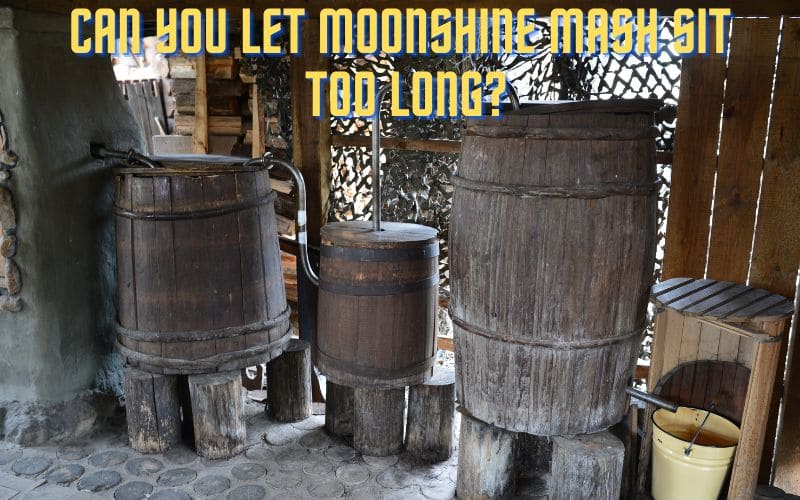Can You Let Moonshine Mash Sit Too Long? Mash Advice For You

Introduction
Welcome to our in-depth exploration of the effects of letting moonshine mash sit too long. In this article, we will address the impact of prolonged sitting on the moonshine mash, the best practices to prevent over-sitting, and the significance of maintaining quality throughout the distillation process. Join us on this educational journey as we uncover the crucial factors related to moonshine production.
Answer to the Question
Can you let moonshine mash sit too long? The simple answer is yes, and it can have significant implications on the quality of the final product. Allowing moonshine mash to sit for excessive periods can lead to undesirable flavors, decreased alcohol content, and potential contamination. Therefore, it is essential to understand the effects of prolonged sitting on the moonshine mash and implement preventive measures.
Supporting Factors
When moonshine sits for an extended period, it undergoes various chemical changes that can significantly impact its flavor, potency, and safety. One of the most noticeable effects of moonshine aging is its flavor profile, which can become smoother and more nuanced over time as it interacts with the container it’s stored in and any additives or infusions present. However, if left sitting for too long, moonshine may also experience undesirable changes, such as oxidation, which can lead to a decrease in quality and taste. Oxidation can cause the alcohol to develop off-flavors and lose some of its initial potency, resulting in a less enjoyable drinking experience.
Here are some potential effects of moonshine sitting for too long:
- Oxidation leading to a decrease in quality and taste
- Loss of potency as alcohol evaporates
- Changes in color, with the liquid potentially darkening over time
- Increased risk of contamination if stored improperly
- Formation of sediments or impurities at the bottom of the container
To preserve the quality of moonshine and prevent it from deteriorating, it’s essential to store it properly in a cool, dark place away from direct sunlight and extreme temperatures. Additionally, using airtight containers can help minimize oxidation and maintain the spirit’s integrity for longer periods. Regularly monitoring the moonshine’s appearance, aroma, and taste can also help determine if it’s still suitable for consumption or if it has passed its prime.
Preventing Over Sitting
Preventing moonshine from sitting for too long is crucial to maintain its quality and safety. One effective method is to store moonshine in airtight containers that limit exposure to air. Oxygen can degrade the alcohol over time, leading to changes in flavor and potentially even spoilage. Mason jars or stainless steel containers with tight-sealing lids are ideal for this purpose. Additionally, storing moonshine in a cool, dark place can slow down chemical reactions that may alter its taste and composition. Direct sunlight and high temperatures can accelerate the aging process, causing unwanted changes in the moonshine’s flavor profile.
Regularly rotating moonshine batches is another strategy to prevent it from sitting for too long. By keeping track of production dates and consumption rates, you can ensure that older batches are used first while fresher batches are allowed to mature. This rotation helps maintain a consistent supply of high-quality moonshine and reduces the risk of spoilage or deterioration over time. Additionally, organizing moonshine tastings or gatherings with friends and family can encourage consumption and prevent excess quantities from lingering unused for extended periods. Through these proactive measures, you can enjoy fresh and flavorful moonshine while minimizing the chances of it sitting idle for too long.
- Store moonshine in airtight containers to limit exposure to air, which can degrade its quality over time.
- Use containers such as mason jars or stainless steel with tight-sealing lids to preserve the moonshine’s flavor and prevent spoilage.
- Keep moonshine in a cool, dark place to slow down chemical reactions that may alter its taste and composition.
- Rotate moonshine batches regularly, prioritizing the use of older batches first to ensure a consistent supply of high-quality moonshine.
- Track production dates and consumption rates to manage inventory effectively and prevent excessive sitting of moonshine.
- Organize moonshine tastings or gatherings to encourage consumption and prevent excess quantities from lingering unused for extended periods.
- Consider sharing moonshine with friends and family to enjoy it responsibly and ensure that it doesn’t sit idle for too long.
Conclusion
In conclusion, the answer to the question “Can you let moonshine mash sit too long?” is yes. While letting the mash sit for a longer period of time may result in a stronger and more flavorful moonshine, it can also have negative effects on the quality and consistency of the final product. It is important to find a balance between aging the mash and preventing it from sitting for too long.
Sitting too long can result in a decrease in alcohol content, as well as an increase in off-flavors and impurities. This can greatly impact the overall quality of the moonshine and make it less enjoyable to drink. To prevent this, it is important to follow best practices and regularly monitor and test the mash to ensure it is not sitting for too long.
In the end, moonshine is a delicate balance between art and science. While aging the mash can enhance its flavor and complexity, it is important to not let it sit for too long. By following the tips and best practices outlined in this article, you can ensure that your moonshine is of the highest quality and always ready to be enjoyed.
